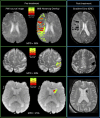Blood-brain barrier profile pretreatment is associated with hemorrhagic transformation after endovascular reperfusion
- PMID: 39462241
- PMCID: PMC11651177
- DOI: 10.1002/acn3.52236
Blood-brain barrier profile pretreatment is associated with hemorrhagic transformation after endovascular reperfusion
Abstract
Background: While advances in endovascular thrombectomy (EVT) have led to high reperfusion rates, most patients treated with EVT do not avoid disability. Post-reperfusion hemorrhagic transformation (HT) is a potential target for improving outcomes. This study examined pretreatment blood-brain barrier (BBB) disruption in tissue that would subsequently become part of the final infarct to evaluate its role in post-EVT HT.
Methods: This post hoc analysis of the FRAME study, which enrolled patients with anterior large vessel occlusion who received EVT within 6 hours of onset, included patients if they had successful pretreatment MRI perfusion weighted imaging (PWI) and underwent successful EVT. BBB disruption was measured as the percent signal change due to gadolinium leakage on the PWI source images prior to thrombectomy. Mean permeability derangement (MPD) was defined as the average of all voxels in the stroke core that are two standard deviations above normal. The primary outcome was hemorrhagic transformation with parenchymal hematoma (PH).
Results: In total, 164 patients were included; mean age was 71 and 48% were female. PH occurred in 57 patients. Median MPD was 13.5% for patients with PH versus 3.6% for patients without (p < 0.0001). Elevated MPD was independently associated with PH with a 20% increased risk of PH for each 5% increase in MPD (OR 1.206; 95% CI 1.037:1.405; p = 0.0147, adjusted for NIHSS and procedure duration).
Conclusions: Even in patients who are successfully recanalized in an early time window, pretreatment BBB disruption in regions that go on to infarct is associated with an increased risk of post-EVT HT.
© 2024 The Author(s). Annals of Clinical and Translational Neurology published by Wiley Periodicals LLC on behalf of American Neurological Association.
Conflict of interest statement
Nothing to report.
Figures



References
MeSH terms
Grants and funding
LinkOut - more resources
Full Text Sources

